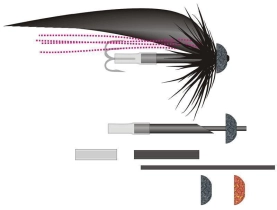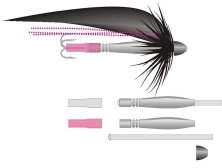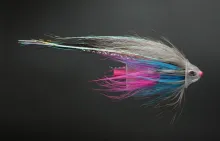It's been some years since The Global FlyFisher's huge article series on tube flies started, and a lot of things have happened in the tube materials market. We try to catch up.
I have tried to keep up with the development in tube materials by editing, deleting and adding bits and pieces to the large Tube Turmoil article series, but I almost had to give up, because there's honestly so much happening that it calls for a new article.
This is it: the article on all the new materials for tube flies.
I will try to go through the different elements - the tubes and tube systems themselves, but no least the many accessories like weights, cones, discs and much more.
The development in other tying materials for tubes has also been almost explosive, and especially within furs we have seen a lot of really excellent new furs from many manufacturers with new colors, bars and really excellent and uniform hair quality. Other materials have also seen the light of day like lots of new types and colors of rubber legs, which are used more and more, and the new and latest fad: fake Jungle Cock printed on plastic. I may return to these materials in a later article. This one deals with the tube "hardware".
I also plan on returning to hooks for tube flies, because even though hook choice might no get the greatest attention from anglers using tubes, they are of course critical and choosing the right style and size isn't necessarily a simple task.
Plain tubes
When I say plain tubes, I mean one-diameter plastic tubes, which may come in longer pieces that you cut to appropriate lengths yourself. They are often available in several diameters, but each tube has one diameter only. These are the classical tubes, which most manufacturers have in drogues.
There isn't much new here, but then again there is. Tubes used to be uniform colors and a few different hues, but during the last few years we have seen translucent tubes and tubes with color flakes or glitter. The selection varies and different manufacturers and shops have an ever changing row of colors.
The so called soft tubes have also become more common. These tubes are used to add length to a fly, typically tied on a bullet or bottle, and are usually bare, simply keeping the hook at a certain distance from the fly body and wing. The tube is different from the junction tube used to connect fly and hook, being rigid enough to keep its shape when the fly is fished.
One new type, which wasn't available when the article series started, is stainless steel tube, specifically meant for larger saltwater flies. Tie on aluminum and salt will take its toll, but use Canadian Tube Flies' stainless tubes, and the tube itself will be the last part that decays.
For those wanting to use steel tubes for lighter flies, Scottish Grays of Kilsyth has their Needle Tubes, which are very fine and thin steel tubes, meant for dressing the traditional, slim hairwinged salmon flies.
New players are constantly emerging to the tube scene, and the last few years we have seen many new and innovative suppliers such as FutureFly, Pro Sportfisher, Tubeworx and many more.
Compound tubes
Three years ago Danish Morten Bundgaard and his company Pro Sportfisher (then named Pro Flytyer) introduced the Pro Tube system, which was also later renamed, and now bears the name Pro Flytying System.
The Flexitube was the first of Pro Sportfisher's tube systems, and was the first to introduce the concept of two thicknesses in one tube. Until then fly-tyers who wanted to tie on compound tubes had to make them by combining two tubes - a thick and a thin, as we have described it many times.
Morten's tubes were radically different and combining the tubes with a whole row of weights, cones and discs he created a highly modular and flexible system with endless options for combination.
Since then Pro Sportfisher has introduced Nanotubes and Microtubes, which are variations of the same concept, but with more complex shapes, and - as the names imply - the option to build more compact flies.
Pro Sportfisher has also added new shapes to the cones and discs, which used to be plain bullet shaped metal cones or flat ("Chinese hat") plastic discs. Pro Sportfisher has a series of different discs and cones with and without holes - so called Sonic Discs - and with varying shapes. You will find similar perforated discs in other manufaturer's assortments, like FutureFly's Drainer Discs.
Throughout the whole system there's a wealth of colors available, which enables the fly-tyer to create colorful flies using the different components in combination.
Cones galore
Once a cone was a cone, and the way you finished a tube fly was with a plain brass cone, maybe in black or sometimes even in a bright color.
But then Swedish Guideline started with new and different shapes in its FITS (Frödin Improved Tube System) featuring the wider and flatter turbo and soft discs, which create turbulence and literally make the fly grow and pulse.
Pro Sportfisher and many others followed up with new shapes, materials and colors on what used
to be a plain cone to finish the tube fly with. These days we have a wealth of different offers in all thinkable shapes and materials.
A very special cone type is Falkenberg's Softcones, which are made from foam, and meant to replace voluminous and light heads like muddler heads. They will add bulk and even some floatability to your flies, but save you handling deer hair, spinning and trimming.
Soft, hard, heavy, light, metal, foam, bright, transparent, solid, holed, flat, pointed... you name it and you almost certainly have it from one of the many suppliers of tube materials, which almost all have large selections in many sizes, shapes, materials and colors.
Soft, hard, heavy, light, metal, foam, bright, transparent, solid, holed, flat, pointed... you name it
Bullets, bottles and more
We have already covered a ton of different bottles including the widely available Bidoz brass and aluminum bottles designed by yours truly. These have by the way come in a slimmer version now. The original is 4 millimeters in diameter, and the new, slim model is just 3 millimeters in diameter, enabling you to tie more slender and lighter flies.
The number of bottles from both Bidoz as well as other manufacturers grows constantly and the selection of sizes, weights, shapes and materials seems endless.
Tubes designed by the late Juri Shumakov are quite common now. French Andre Bidoz has a whole series.
The Finish company Eumer still has a vast selection of their tubes in all colors and shapes.
Stuart Anderson's Canadian Tube Flies has a set of new shapes, amongst them models called Barbell, Torpedo and Deepwater.
In the UK you will find Foxy-Tails, a company specializing in fur, but also with a selection of tubes and weights. They have find soft tubes in different colors and several different bottle-shaped weights in their catalog under the name TFS - Tube Fly System. The tubes are compatible with FutureFly's tubes, and will be easy to combine with other brands.
Stonfo is Italian and a new player in the tube market - at least to me - and can obviously deliver several different tube fly components such as cones, heads, bottles and plain plastic tubes. They are available from several shops, especially in Italy of course, but also in the UK.
The technique for using the bottle tubes is the same that we have already described many times, but the number of options just keeps growing.
Heads
A fairly new development in tube flies adding heads with eyes to the tubes to create nice baitfish imitations. Many of the heads have been designed to be used with hooks, but will work fine on tubes with a little delicate violence.
Lately we have seen heads developed specifically for tubes, and Pro Sportfisher's Softheads are a prime example. Light and flexible and available in several sizes, all easily added to a tube fly, they are already widely used for baitfish patterns for saltwater and pike use. The have recesses for eyes, and make a very good finish on most small fish imitations.
FutureFly also has a head with room for eyes, and their Hotlips head should soon be available (autumn 2012).
Flymen's Fish Skulls and Sculpin Helmets have been made for hooks, but will fit tightly over most inner tubes, and add the same perfect head to fish imitations.
French Bodiz Products has long had their Kameleon Head, which is also for hooks, but can be fitted on an inner tube in the larger sizes. The new head "La Bornandine" has a short tube built in, and will allow you to tie on its rear tube and/or extend it with a plastic tube.
Also from Bidoz come the so called Diam's Cones (faceted tungsten, gold or silver finish) and Heavy Cones (smooth brass, gold or silver finish). They are ordinary but heavy cones with room for eyes and a hole sufficiently large to fit on a tube. They come in three fairly large sizes (7, 8.5 and 10 millimeters Ø), perfect for flies that call for a large and heavy head.
Hooks
One part of the whole tube fly scene, which seems to sometimes be forgotten is hook selection, and especially suitable single hooks have been hard to find. Tubes can in general be equipped with most short shank straight eye hooks, and many specimen hooks can work, but there are suppliers who aim for hooks specifically produced or selected for tubes.
Canadian Tube Flies has a large selection of both well known and lesser known hook brands, and their Egret hooks are especially interesting, being very well suited for tubes and available in several sizes, also smaller ones.
Getting a hold of doubles and trebles for tube flies is not as big an issue since many of the large hook manufacturers such as Partridge/Mustad, Owner and Kamasan all produce them. More on hooks here.
Odds and ends
In the department of really different tube systems, British Tubeology must be taking the first prize. Their system is based on a screw-in principle, where the metal tube has a male thread in the front part, and all the cones have a similar female thread. That enables you to screw on different cones at waterside, which again enables you to vary appearance and weight of the same fly. The system also contains spinner-like components like spinner blades, separator rings and really large cones, effectively converting your fly to a spinner.
Update January 2017: It seems that Tubeology has disappeared off the map. Their web site is gone, and they have been very quiet lately.
Last but not least such totally extravagant and crazy products as Danish FutureFly's Funky Beads totally break the barrier of what you can put on a modern tube fly. In spite of what you'd think, it is actually a fly tying material...
|
|
So the development in tube flies keeps on, and I'm sure that in a year or two I will have to extend this article again, because with the frequency we're seeing new ideas and new materials now, there no reason to think that the pace will go down anytime soon.
Manufacturers and shops mentioned here
More on tube flies
Hand picked for this article
- Log in to post comments





















































Nils,
Just a quic
Nils,
Just a quick question....on the grey ghost variant in this article, when you put the pro soft disc on reverse on the back of the flexitube are you laying down a small layer of glue to hold it in place.....or what are you doing there??? Because wouldn't the disc just ride up the tube if you didn't...just curious...great flies though.
I used to buy tubes
I used to buy tubes to tie on and still buy micro tubes or nesting tubes to tie my fresh water flies on. Recently my wife bought some Q-Tips. When I picked one up to use, I immediately realized that it felt like plastic instead of rolled paper. After using the Q-Tip I cut off the ends and sure enough they were plastic. They measured 2 1/2 to 3" long and very ridged. I decided that recycling was the best why to go and saved me a lot of money on the purchase of tubes. I tied a tube fly on this plastic tube and it was beautiful. The plastic is white and takes coloring by use of magic marker nicely. Now the Q-Tips serve two purposes and I am contributing to a clean earth by reusing the plastic tubes. Give it a try, you'll love it.
Claus, I had seen
Claus,
I had seen these tubes before, but forgotten them in the flurry of new stuff... they can be found at Grays of Kilsyth and have also been added to the text above.
Martin
Martin,
Don't forge
Martin,
Don't forget the extremely thin stainless steel tubes from Grays of Kilsyth. They can be used to design some very interesting flies and are unlike many other products on the market. I like them.
Claus Bech-Petersen
Santiago,
Thanks
Santiago,
Thanks a lot for your reply, and I know what you mean. But if you look at the flies shown in this article you see tube flies using some of the components covered in the article, and still very creative, some of them quite complex and all of them very nicely designed flies if you ask me.
I have to agree on some of the newer prefabricated bodies and shells. The cones, heads and sculls available for tube flies help add weight and shape, but can hardly be said to make the fly tying faster or more convenient. In my opinion they are just a fine way of finishing the fly with style.
But I certainly respect your opinion.
Martin
You're right Martin,
You're right Martin, my comment sounds too strict.
In my opinion, flytying has much to do with art and creativity. Tube flies are excellent and I consider them just a different design that came up from a very creative flytier's mind many years ago.
Having said that, I also think that pre manufactured components as plastic heads, fish skulls, ready-to-use brushes and bodies, etcetera are focused on getting the job done fast.
My connection with flytying is more related to a pleasant "do it yourself" hobbie than a "fast food" job style.
I don't want to convince anyone, It's just my humble opinion.
Regards!
Santiago.-
Santiago,
You wil
Santiago,
You will have to explain that... why should tube fly tying be assembling more than tying?
I can tell you that some of the best tyers I know also tie tube flies, and trust me: there's no assembling there, but really excellent tying skills that use fur, feathers and synthetics like on all other types of flies. Just because you use a tube in stead of a hook and a cone in stead of a brass bead or stick-on eyes, tying tube flies is no more assembling than tying a nymph, a saltwater fly or a dry.
Martin
Seems that fly-tying
Seems that fly-tying is turning to fly-assembling. Sorry I don't like it.